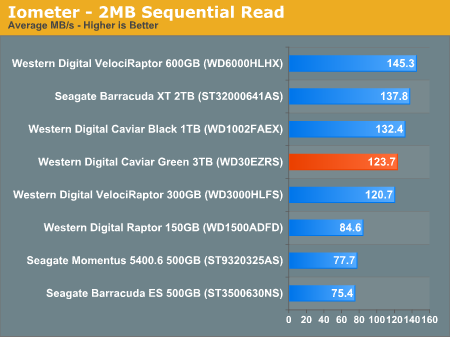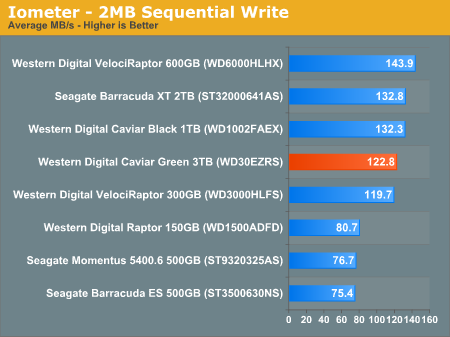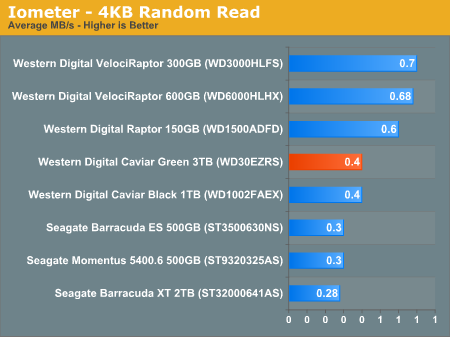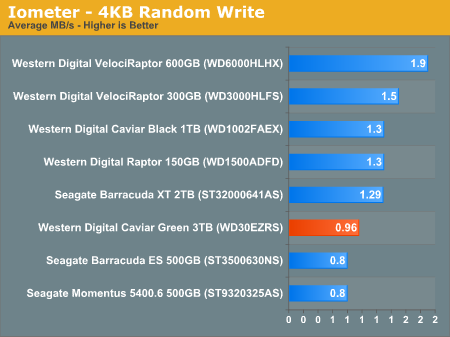Western Digital Caviar Green 3TB and My Book Essential 3TB Drives Reviewed
by Anand Lal Shimpi on October 19, 2010 1:43 PM EST- Posted in
- Storage
- HDDs
- Western Digital
- 3TB
The Test
| CPU | Intel Core i7 965 running at 3.2GHz (Turbo & EIST Disabled) |
| Motherboard: | Intel DX58SO (Intel X58) |
| Chipset: | Intel X58 + Marvell SATA 6Gbps PCIe |
| Chipset Drivers: | Intel 9.1.1.1015 + Intel IMSM 8.9 |
| Memory: | Qimonda DDR3-1333 4 x 1GB (7-7-7-20) |
| Video Card: | eVGA GeForce GTX 285 |
| Video Drivers: | NVIDIA ForceWare 190.38 64-bit |
| Desktop Resolution: | 1920 x 1200 |
| OS: | Windows 7 x64 |
Sequential Read/Write Speed
Using the latest build of Iometer I ran a 3 minute long 2MB sequential test over the entire span of the drive. The results reported are in average MB/s over the entire test length. Sequential read/write performance is very close to the older 7200RPM 1TB Caviar Black. The 3TB Caviar Green manages to come within 10% of the older 7200 RPM drive.


Random Read/Write Speed
This test writes 4KB in a completely random pattern over an 8GB space of the drive to simulate the sort of random access that you'd see on an OS drive (even this is more stressful than a normal desktop user would see). Random read performance takes place over the entire LBA span of the drive so the two numbers will be different. I perform three concurrent IOs and run the test for 3 minutes. The results reported are in average MB/s over the entire time.

Both random read and write performance is pretty reasonable for a sub-6000 RPM hard drive. You're definitely not going to be as fast as a modern day 7200 RPM drive or a 10K RPM Raptor for random opterations, but for large file storage you should be fine.











48 Comments
View All Comments
risa2000 - Wednesday, October 20, 2010 - link
I have 4 years "old" Intel board D975XBX, which sports EFI boot. The only effect I saw so far, it confuses Win 7 Ultimate installation disk to the point it presents strange menu after the boot, which does not display the choices. Searching on Internet returns this is related to EFI (since it has been also observed on Intel Macs). So EFI has been around for quite a while already - whether it works is different story.For 4KiB sector size. I hope WD will soon come out clear on this point and have their drives to report it properly. So far I have seen two Caviar Greens (640G and 2TB), which both claimed logical and physical size 512b. It seems the situation now is forced by Windows XP compatibility, but it then has negative impact on any other system and performance if not handled manually and correctly.
For example the mentioned 4K random read&write: Were those 4K blocks aligned to physical disk sectors or were they random on 512b boundary?
alpha754293 - Wednesday, October 20, 2010 - link
I thought that LBA48 was supposed to fix the whole LBA32 issue?At 48-bits of Logical Block Addressing, that would be 2^48 blocks. Multiply that by even 512-byte sectors, you end up with 144,115,188,075,855,872 bytes of storage max. (144 TB).
QChronoD - Wednesday, October 20, 2010 - link
This drive looks very interesting. I'm looking to add a bunch more storage to my computer and these new 3TB are very tempting especially with such a small price premium.Since I have 8 open drive bays but no free SATA ports, I'm debating between getting a good 12 or 16ch raid card and then running one ginormous RAID5 or 6, or just picking up a pair of cheap SATA cards and dealing with a dozen drive letters.
ATM I'm leaning towards RAID since I think I would be less likely to loose data. Anyone's opinion on which way I should go (or what cards/drives to get)
mark3450 - Wednesday, October 20, 2010 - link
My understanding is that Western Digital is now deliberately crippling RAID support in all new consumer level drives. Specially by removing the users ability to set what WD terms the "Time-Limited Error Recovery" flag in the drives firmware.http://en.wikipedia.org/wiki/Time-Limited_Error_Re...
Anyone have and idea if this is also the case for this drive?
JNo - Wednesday, October 20, 2010 - link
First of all, I think most of us know that a 3TB 5,400rpm (ok 'up to 6k rpm') is not meant to be a boot drive so there is not much point reiterating it so many times or carrying out 20 different tests that all show it. However I do take point with one statement:"At $239 for an internal drive, the 3TB offering isn't too expensive. You can shave off another penny or two per GB if you go with a smaller drive, but if you want the space of a single drive Western Digital's offering isn't a bad deal."
A penny or 2 per gigabyte is a *huge* amount when gigabytes are only 3-6p each.
In the UK, the pre-order price for this drive (scan.co.uk) is £189.05 or 6.3p/gb whereas the 2TB caviar green (WD20EARS) is only £73.21 or 3.7p/gb. That's 42% less! I know there is always a premium for cutting edge but I'm not sure there are too many people for whom 3TB is mission critical where 2TB would fail.
So unless you have an SFF/HTPC with v limited drive bays, the 2TB drives win everytime. You've admitted yourselves that speed is not a factor, that these are slow storage drives, so the only metric of interest, really, is cost / gb. There's a lot of analysis this write up for a straight forward conclusion unfortunately.
softdrinkviking - Wednesday, October 20, 2010 - link
So, does using Linux Effect the hardware requirements?You still need a mobo with efi support, right?
And you also are restricted by SATA and have to use IDE?
mariush - Thursday, October 21, 2010 - link
Is Anandtech so poor that they can't buy a license for that software used to determine the transfer speed? It shows "trial version" in the top left corner...
I guess the extra cost is also in part because of the controller, which is a custom HighPoint RocketRAID 620 (see newegg.com/Product/Product.aspx?Item=N82E16816115075) that's available for 60$ ... well custom, if you think custom means removing the beeper.
I guess if you need a sata controller or you wish to sell the controller on eBay it would be worth getting this drive.
marsbound2024 - Thursday, October 21, 2010 - link
"It's barely any faster than an old Seagate Barracuda ES and even slower than the old 150GB VelociRaptor. "I believe it is just "Raptor" not "VelociRaptor."
Hrel - Thursday, October 21, 2010 - link
The only way I'd forgo using a 7200rpm drive is if I could get a 500+GB SSD for under 100 bucks. That's the only way I could install every single program I use and have enough space space to keep things running smoothly. And that's today, I'd want room for expansion, more games, bigger games, bigger media editing programs. SSD's are still WAY WAY WAY too expensive. The price of them needs to come WAY down or they'll never see market penetration. I'm honestly shocked they're still so expensive. Where's the sub 50 cents per GB SSD?Hrel - Thursday, October 21, 2010 - link
I've seen 1TB drives for 50 bucks. That's 5 cents per GB. You'd think we could get at least 25 cents per GB in SSD's. Hell, they're only 5 times faster at best, so 5 times more/GB seems totally fair. Greedy Bastards; most us are still struggling out here and they're just getting greedier.